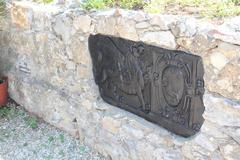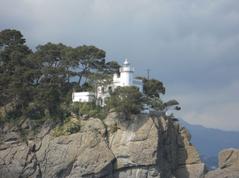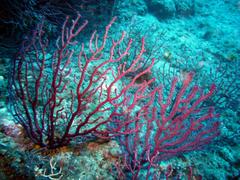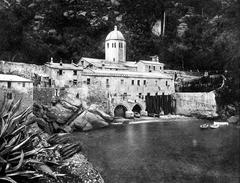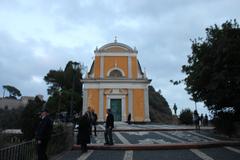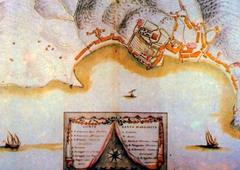Visiting Via San Nicolò: Hours, Tickets, and Nearby Attractions
Publication Date: 19/07/2024
Introduction to Via San Nicolò
Via San Nicolò, in the charming coastal town of Rapallo, Italy, is a captivating destination for visitors seeking a blend of history, culture, and picturesque landscapes. Nestled in the Liguria region, Rapallo itself is rich with history dating back to Roman times, and Via San Nicolò serves as a living testament to this enduring legacy. Named after Saint Nicholas, the patron saint of sailors, this street reflects Rapallo’s historical connection to maritime activities. The architecture along Via San Nicolò showcases a blend of medieval and Renaissance styles, with notable structures like the Oratorio dei Bianchi and the Palazzo del Podestà providing glimpses into the town’s past. Cultural events, such as the annual Festa di San Nicolò, bring the street to life, celebrating local heritage with processions, music, and traditional food (Exploring Via San Nicolò - History, Visitor Tips, and Cultural Significance in Rapallo). For visitors, Via San Nicolò offers not only historical landmarks but also a vibrant array of artisan shops, cafes, and restaurants, making it a must-visit destination for anyone exploring the Ligurian coast.
Table of Contents
- Introduction
- Historical Background
- Architectural Significance
- Cultural Significance
- Notable Landmarks
- Oratorio dei Bianchi
- Palazzo del Podestà
- Torre Civica
- Chiesa di San Nicolò di Capodimonte
- Castello di Rapallo
- Lungomare Vittorio Veneto
- Basilica dei Santi Gervasio e Protasio
- Porta delle Saline
- Museo del Merletto
- Parco Casale
- Teatro Auditorium delle Clarisse
- Funivia Rapallo-Montallegro
- Villa Tigullio
- Visitor Tips
- Preservation Efforts
- FAQ
- Conclusion
Historical Background
Via San Nicolò, located in the picturesque town of Rapallo, Italy, is a street steeped in history and cultural significance. Rapallo itself has a rich history dating back to Roman times, and Via San Nicolò is a testament to the town’s enduring legacy. The street is named after Saint Nicholas, the patron saint of sailors, which reflects Rapallo’s historical connection to maritime activities.
During the Middle Ages, Rapallo was a strategic coastal town, often caught in the crossfire of regional conflicts. The town’s fortifications, including the famous Castello di Rapallo, were built to protect against pirate raids and invasions. Via San Nicolò, situated near the heart of the town, played a crucial role as a thoroughfare for both locals and travelers.
Architectural Significance
The architecture along Via San Nicolò is a blend of medieval and Renaissance styles, showcasing the town’s evolution over centuries. Many buildings feature intricate facades, arched doorways, and frescoes that have been meticulously preserved. One notable structure is the Oratorio dei Bianchi, a small chapel dating back to the 16th century, known for its beautiful Baroque interior and religious artworks.
The street itself is narrow and winding, typical of medieval Italian towns, which adds to its charm. Walking along Via San Nicolò, visitors can admire the cobblestone pavement and the well-preserved buildings that line the street. The architectural details provide a glimpse into the past, making it a living museum of Rapallo’s history.
Cultural Significance
Via San Nicolò is not just a historical landmark; it is also a cultural hub. The street is home to several artisan shops, cafes, and restaurants that offer a taste of local life. These establishments often occupy buildings that have been in use for centuries, adding to the authentic experience.
One of the cultural highlights of Via San Nicolò is the annual Festa di San Nicolò, held on December 6th. This festival celebrates the feast day of Saint Nicholas with processions, music, and traditional food. The event attracts both locals and tourists, turning the street into a lively celebration of Rapallo’s heritage.
Notable Landmarks
Oratorio dei Bianchi
This chapel, also known as the Oratory of the Whites, is a significant religious site on Via San Nicolò. It was built in the 16th century and is renowned for its Baroque architecture and religious art. The interior features elaborate stucco work and paintings that depict scenes from the life of Saint Nicholas.
Palazzo del Podestà
Another notable building on Via San Nicolò is the Palazzo del Podestà, which dates back to the 14th century. This historic palace once served as the residence of the town’s chief magistrate. Today, it houses a museum that showcases artifacts from Rapallo’s history, including medieval weapons, documents, and artworks.
Torre Civica
The Civic Tower, located at the end of Via San Nicolò, is a medieval tower that offers panoramic views of Rapallo and the surrounding coastline. The tower is a remnant of the town’s defensive structures and provides insight into the strategic importance of Rapallo in the past.
Chiesa di San Nicolò di Capodimonte
The Chiesa di San Nicolò di Capodimonte is a historic church located on Via San Nicolò. This church, dating back to the 12th century, is a prime example of Romanesque architecture. It features a simple yet elegant façade and a bell tower that offers panoramic views of Rapallo and the Ligurian Sea. The interior of the church is adorned with frescoes and religious artifacts that provide a glimpse into the region’s rich ecclesiastical history. Visitors can explore the church and its surroundings, which include a small garden perfect for quiet reflection. The church is open from 9 AM to 6 PM daily. For more information, visit the official website.
Castello di Rapallo
Located near Via San Nicolò, the Castello di Rapallo, also known as the Castle of Rapallo, is a must-visit attraction. Built in the 16th century to protect the town from pirate attacks, this fortress stands as a testament to Rapallo’s strategic importance in maritime defense. The castle now serves as a museum, showcasing artifacts and exhibits related to the town’s history. Visitors can explore the castle’s interior, including its dungeons and towers, and enjoy stunning views of the Gulf of Tigullio from its ramparts. Tickets are priced at €5 for adults and €3 for children. More details can be found on the Rapallo tourism website.
Lungomare Vittorio Veneto
Via San Nicolò leads directly to the Lungomare Vittorio Veneto, Rapallo’s picturesque waterfront promenade. This bustling area is lined with palm trees, cafes, and shops, making it an ideal spot for a leisurely stroll. The promenade offers breathtaking views of the sea and the surrounding hills. It’s also a great place to experience local culture, as it hosts various events and festivals throughout the year. Visitors can enjoy a meal at one of the many seafood restaurants or simply relax on a bench and watch the world go by. For event schedules and more information, visit the Lungomare Vittorio Veneto page.
Basilica dei Santi Gervasio e Protasio
A short walk from Via San Nicolò, the Basilica dei Santi Gervasio e Protasio is one of Rapallo’s most significant religious sites. This basilica, originally built in the 6th century and later reconstructed, features a blend of architectural styles, including Romanesque, Gothic, and Baroque elements. The interior is richly decorated with frescoes, marble altars, and a stunning organ. The basilica also houses several important relics and artworks, making it a must-visit for art and history enthusiasts. For visiting hours and more details, check the basilica’s website.
Porta delle Saline
The Porta delle Saline is an ancient gate that once served as the main entrance to Rapallo. Located near Via San Nicolò, this historic landmark dates back to the medieval period and is one of the few remaining parts of the old city walls. The gate is named after the nearby salt pans, which were an important part of Rapallo’s economy in the past. Today, the Porta delle Saline stands as a symbol of the town’s rich history and offers a glimpse into its medieval past. Visitors can explore the gate and the surrounding area, which is filled with charming streets and historic buildings. More information can be found on the Rapallo historical sites page.
Museo del Merletto
The Museo del Merletto, or Lace Museum, is located near Via San Nicolò and is dedicated to the art of lace-making, a traditional craft in Rapallo. The museum showcases a collection of intricate lace pieces, including garments, accessories, and household items. Visitors can learn about the history of lace-making in the region and see demonstrations of the craft. The museum also offers workshops where visitors can try their hand at lace-making. For more information, visit the Museo del Merletto website.
Parco Casale
Parco Casale is a beautiful park located near Via San Nicolò, offering a peaceful retreat from the bustling town center. The park features well-maintained gardens, walking paths, and a variety of plants and trees. It’s an ideal spot for a picnic or a leisurely walk. The park also has a playground for children and several benches where visitors can relax and enjoy the natural surroundings. Parco Casale is a great place to unwind and enjoy the beauty of Rapallo. For more details, visit the Parco Casale page.
Teatro Auditorium delle Clarisse
The Teatro Auditorium delle Clarisse is a cultural hub located near Via San Nicolò. This historic theater hosts a variety of performances, including plays, concerts, and dance shows. The theater is housed in a former convent, adding to its unique charm. Visitors can enjoy a wide range of cultural events and experience the vibrant arts scene in Rapallo. The theater also offers guided tours, providing insights into its history and architecture. For event schedules and ticket information, visit the theater’s website.
Funivia Rapallo-Montallegro
The Funivia Rapallo-Montallegro is a cable car that offers a scenic ride from Rapallo to the Sanctuary of Our Lady of Montallegro. The cable car station is located near Via San Nicolò, making it easily accessible for visitors. The ride provides stunning views of the Ligurian coast and the surrounding hills. At the top, visitors can explore the sanctuary, which is a popular pilgrimage site, and enjoy panoramic views of the region. The cable car operates year-round, and more information can be found on the Funivia Rapallo-Montallegro website.
Villa Tigullio
Villa Tigullio is a historic villa located near Via San Nicolò, surrounded by beautiful gardens and offering stunning views of the sea. The villa houses the Civic Museum, which features exhibits on the history and culture of Rapallo. Visitors can explore the museum’s collection, which includes archaeological artifacts, artworks, and historical documents. The villa’s gardens are also worth a visit, with their well-manicured lawns, fountains, and a variety of plants and flowers. For more information, visit the Villa Tigullio page.
Visitor Tips
Visiting Hours and Tickets
- Visiting Hours: Via San Nicolò is accessible at all hours, but specific landmarks like the Oratorio dei Bianchi may have restricted visiting hours. Check the official Rapallo tourism website for details.
- Tickets: Most landmarks on Via San Nicolò do not have an entrance fee, but donations are appreciated to help with preservation efforts. It is best to check individual sites for specific information.
Best Time to Visit
- The best time to visit Via San Nicolò is during the spring and fall when the weather is mild, and the town is less crowded. The Festa di San Nicolò in December is also a great time to experience the local culture and festivities.
Walking Tour
- A walking tour of Via San Nicolò is highly recommended. Many local guides offer tours that provide historical context and interesting anecdotes about the street and its landmarks.
Local Cuisine
- Don’t miss the opportunity to sample local Ligurian cuisine at the cafes and restaurants along Via San Nicolò. Specialties include focaccia, pesto, and fresh seafood dishes.
Shopping
- The artisan shops on Via San Nicolò offer unique souvenirs, including handmade jewelry, ceramics, and textiles. These items make for great keepsakes or gifts.
Accessibility
- The narrow, cobblestone streets may pose challenges for visitors with mobility issues. Consider guided tours that offer assistance.
Photography
- The narrow, winding street and historic buildings provide excellent photo opportunities. Early morning or late afternoon light is ideal for capturing the charm of Via San Nicolò.
Preservation Efforts
Preserving the historical and cultural integrity of Via San Nicolò is a priority for the local community and authorities. Restoration projects are regularly undertaken to maintain the buildings and prevent deterioration. These efforts ensure that future generations can continue to enjoy and learn from this historic street.
In recent years, there has been a focus on sustainable tourism to balance the influx of visitors with the need to protect the street’s heritage. Initiatives include promoting off-season travel, encouraging respectful behavior among tourists, and supporting local businesses that adhere to preservation guidelines.
FAQ
- What are the visiting hours for Via San Nicolò?
- Via San Nicolò is accessible at all hours, but specific landmarks like the Oratorio dei Bianchi may have restricted visiting hours. Check the official Rapallo tourism website for details.
- Is there an entrance fee for the landmarks on Via San Nicolò?
- Most landmarks on Via San Nicolò do not have an entrance fee, but donations are appreciated to help with preservation efforts. It is best to check individual sites for specific information.
- What are the best times to visit Via San Nicolò?
- The best times to visit are during the spring and fall when the weather is mild. The Festa di San Nicolò in December is also a great time to experience local culture and festivities.
Conclusion
Via San Nicolò is more than just a street; it is a living testament to Rapallo’s rich history and cultural heritage. Its historical significance, architectural beauty, and vibrant local culture make it a must-visit destination for anyone exploring the Ligurian coast. By exploring these key attractions and following these tips, visitors can have a memorable and enriching experience on Via San Nicolò in Rapallo, Italy.
